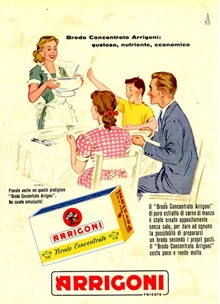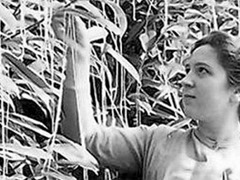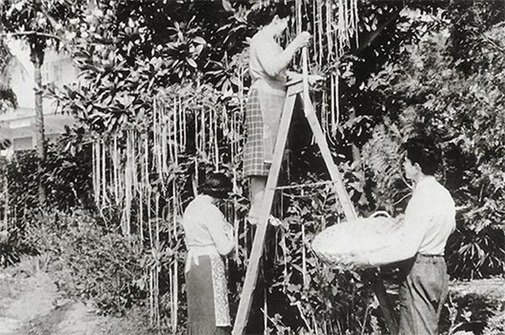A classic American recipe found in “Delicious Recipes
with Mueller’s Macaroni Products” published
by C F Mueller Co in the 1940s
Category Archives: Macaroni
Macaroni and Cheese / Makaroni og Ost
The History of Pasta
Nothing says Italy like its food, and nothing says Italian food like pasta. Pasta is integrant part of Italy’s food history Wherever Italians immigrated they have brought their pasta along, so much so today it can be considered a staple of international cuisine. Unlike other ubiquitous Italian products like pizza and tomato sauce, which have a fairly recent history, pasta may have a much older pedigree, going back hundreds -if not thousands- of years. Unravelling the long and often complex history of this dish we have to look at its origins and some of the myths surrounding it.
Many school children were taught that the Venetian merchant Marco Polo brought back pasta from his journeys to China (along with gelato, some believed…). Some may have also learnt that Polo’s was not a discovery, but rather a rediscovery of a product once popular in Italy among the Etruscans and the Romans. Well, Marco  Polo might have done amazing things on his journeys, but bringing pasta to Italy was not one of them: noodles were already there in Polo’s time.
Polo might have done amazing things on his journeys, but bringing pasta to Italy was not one of them: noodles were already there in Polo’s time.
There is indeed evidence of an Etrusco-Roman noodle made from the same durum wheat used to produce modern pasta: it was called “lagane” (origin of the modern word for lasagna). However this type of food, first mentioned in the 1st century AD, was not boiled, as it is usually done today, but ovenbaked. Ancient lagane had some similarities with modern pasta, but cannot be considered quite the same. The country will have to wait a few centuries for its most popular dish to make a further culinary leap forward.
 Like so much of southern Italian life, the Arabic invasions of the 8th century heavily influenced regional cuisine. Today, the presence of Arabic people in the south of the peninsula during the Middle Ages is considered the most likely reason behind the diffusion of pasta.
Like so much of southern Italian life, the Arabic invasions of the 8th century heavily influenced regional cuisine. Today, the presence of Arabic people in the south of the peninsula during the Middle Ages is considered the most likely reason behind the diffusion of pasta.
The modern word “macaroni” derives from the Sicilian term for kneading dough with energy, as early pasta making was often a laborious, day-long process. How these early dishes were served is not truly known, but many Sicilian pasta recipes still include typically middle eastern ingredients, such as raisins and cinnamon, which may be witness to original, medieval recipes.
This early pasta was an ideal staple for Sicily and it easily spread to the mainland since durum wheat thrives in Italy’s climate. Italy is still a major producer of this hard wheat, used to make the all-important semolina flour.
 By the 1300’s dried pasta was very popular for its nutrition and long shelf life, making it ideal for long ship voyages. Pasta made it around the globe during the voyages of discovery a century later. By that time different shapes of pasta have appeared and new technology made pasta easier to make. With these innovations pasta truly became a part of Italian life. However the next big advancement in the history of pasta would not come until the 19th century when pasta met tomatoes.
By the 1300’s dried pasta was very popular for its nutrition and long shelf life, making it ideal for long ship voyages. Pasta made it around the globe during the voyages of discovery a century later. By that time different shapes of pasta have appeared and new technology made pasta easier to make. With these innovations pasta truly became a part of Italian life. However the next big advancement in the history of pasta would not come until the 19th century when pasta met tomatoes.
Although tomatoes were brought back to Europe shortly after their discovery in the New World, it took a long time for the plant to be considered edible. In fact tomatoes are a member of the nightshade family and rumors of tomatoes being poisonous continued in parts of Europe and its colonies until the mid 19th century (check the history of tomato here). Therefore it was not until 1839 that the first pasta recipe with tomatoes was documented. However shortly thereafter tomatoes took hold, especially in the south of Italy. The rest of course is delicious history.
Pasta Today
 It is estimated that Italians eat over sixty pounds of pasta per person, per year easily beating Americans, who eat about twenty pounds per person. This love of pasta in Italy far outstrips the large durum wheat production of the country; therefore Italy must import most of the wheat it uses for pasta. Today pasta is everywhere and can be found in dried (pasta secca) and fresh (pasta fresca) varieties depending on what the recipes call for. The main problem with pasta today is the use of mass production to fill a huge worldwide demand. And while pasta is made everywhere the product from Italy keeps to time-tested production methods that create a superior pasta.
It is estimated that Italians eat over sixty pounds of pasta per person, per year easily beating Americans, who eat about twenty pounds per person. This love of pasta in Italy far outstrips the large durum wheat production of the country; therefore Italy must import most of the wheat it uses for pasta. Today pasta is everywhere and can be found in dried (pasta secca) and fresh (pasta fresca) varieties depending on what the recipes call for. The main problem with pasta today is the use of mass production to fill a huge worldwide demand. And while pasta is made everywhere the product from Italy keeps to time-tested production methods that create a superior pasta.
Dried Pasta
There are roughly 300 different shapes and varieties of dried pasta in Italy, even more counting regional differences. Shapes range from simple tubes to bow ties (farfalle, which actually means “butterfly”), to unique shapes like tennis rackets (racchette). Many, but not all of these types, are usually available wherever pasta is made. By Italian law dried pasta must be made with 100% durum semolina flour and water, a practice that all but the worst quality pasta makers worldwide have since adhered to. However there are two factors in dried pasta from Italy that make it typically better than most other products: extrusion and drying methods.
Dried pasta, especially the more complex shapes (such as radiatore) are designed for grabbing and holding onto sauces. Dried tube pasta (ziti or penne) often has ridges or slight abrasions on the surface to hold onto the pasta sauce as well. These ridges and bumps are created during the extrusion process, when the pasta is forced from a copper mold and cut to desired length before drying. These molds,  while expensive and prone to wear are favored for making the best dried pasta. However most producers worldwide use steel molds that produce pasta that is too smooth to hold onto sauce. Fortunately more pasta makers outside of Italy are starting to use the older style copper molds.
while expensive and prone to wear are favored for making the best dried pasta. However most producers worldwide use steel molds that produce pasta that is too smooth to hold onto sauce. Fortunately more pasta makers outside of Italy are starting to use the older style copper molds.
After the pasta is cut it must be dried using a process of specific temperature and time. This is another area where mass produced pasta falls short of good Italian pasta made the correct way. The mass produced pastas are dried at very high temperatures for a shorter time than quality pasta. Traditional pasta is allowed to dry slower, up to 50 hours at a much lower temperature. It is after the pasta is fully dried that it is packaged. The result is a product with a much better mouth-feel, quicker cooking time, and superior sauce holding noodles.
Fresh Pasta
 Essentially all pasta starts out as fresh pasta but some is made to be eaten “soft”. Fresh pasta can be made with slightly different ingredients than the dried variety. Many northern regions of Italy use all-purpose flour and eggs while southern Italy usually makes theirs from semolina and water but it depends upon the recipe.
Essentially all pasta starts out as fresh pasta but some is made to be eaten “soft”. Fresh pasta can be made with slightly different ingredients than the dried variety. Many northern regions of Italy use all-purpose flour and eggs while southern Italy usually makes theirs from semolina and water but it depends upon the recipe.
Serving pasta that is made fresh that day shows a great deal of care in preparation and a high level of pride in the household’s culinary skills. However fresh pasta is not inherently better than dried pasta, it is just different and is used in different situations. Some types of pasta are served only fresh, others only dried and some others can have fresh and dried versions. It is in this case that it can be argued that fresh is better than dried pasta.
 Fresh pasta has been made in households throughout Italy for generations but the region of Emilia-Romagna has the reputation of making the best. Here fresh pasta is often served with cream sauces or a simple sauce of butter and sage while light tomato sauces are reserved for the summer months. Following the simple but important rule of using fresh local ingredients, the Piedmontese serve their fresh pasta with a butter sauce covered with slices of decadent local black truffles. Wherever you are in Italy, being served fresh homemade pasta is a real treat as you can be assured that the pasta was made that day and will have a taste that will make you rethink notions of what good pasta is.
Fresh pasta has been made in households throughout Italy for generations but the region of Emilia-Romagna has the reputation of making the best. Here fresh pasta is often served with cream sauces or a simple sauce of butter and sage while light tomato sauces are reserved for the summer months. Following the simple but important rule of using fresh local ingredients, the Piedmontese serve their fresh pasta with a butter sauce covered with slices of decadent local black truffles. Wherever you are in Italy, being served fresh homemade pasta is a real treat as you can be assured that the pasta was made that day and will have a taste that will make you rethink notions of what good pasta is.
Text from Life In Italy
In Context:
1957 – BBC Fools The Nation
The BBC received a mixed reaction to a spoof documentary broadcast on April 1th about spaghetti crops in Switzerland. The hoax Panorama programme, narrated by distinguished broadcaster Richard Dimbleby, featured a family from Ticino in Switzerland carrying out their annual spaghetti harvest. It showed women carefully plucking strands of spaghetti from a tree and laying them in the sun to dry.
But some viewers failed to see the funny side of the broadcast and criticised the BBC for airing the item on what is supposed to be a serious factual programme. Others, however, were so intrigued they wanted to find out where they could purchase their very own spaghetti bush.
Exotic delicacy
 Spaghetti was not a widely-eaten food in the UK in 1957 and was considered by many as an exotic delicacy. Mr Dimbleby explained how each year the end of March is a very anxious time for Spaghetti harvesters all over Europe as severe frost can impair the flavour of the spaghetti. He also explained how each strand of spaghetti always grows to the same length thanks to years of hard work by generations of growers.
Spaghetti was not a widely-eaten food in the UK in 1957 and was considered by many as an exotic delicacy. Mr Dimbleby explained how each year the end of March is a very anxious time for Spaghetti harvesters all over Europe as severe frost can impair the flavour of the spaghetti. He also explained how each strand of spaghetti always grows to the same length thanks to years of hard work by generations of growers.
This is believed to be one of the first times the medium of television has been used to stage an April Fools Day hoax in Britain.
Text from BBC On This Day








